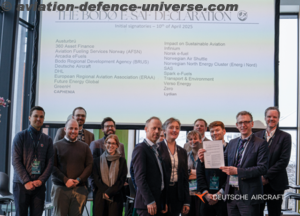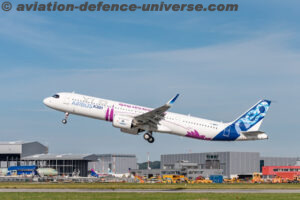Paris. 06 May 2020. During the first two months of the year, operations were practically unaffected by the Covid-19 crisis. The first measures of the 737MAX adaptation plan were implemented and the cash generation has been positive thanks to operations at the start of the year and favorable cut off effects between end of 2019 and beginning of 2020.
The first impacts started to materialize in March across all businesses (20.4% organic decrease year on year). Services (notably aftermarket for civil engines and carbon brakes) and Aircraft Interiors retrofit business declined in line with the sharp fall in air traffic, airlines preserving their cash and operations punctually and locally disrupted. The Covid-19 crisis now affects most of Safran’s activities, both in terms of OE and services.
CEO Philippe Petitcolin commented, “Over the past year, Safran has successfully managed the impact of the 737MAX crisis. The situation we are facing today is of a different order of magnitude, although it remains difficult, at this point, to measure precisely its far-reaching consequences.The actions which my fellow managers and I have launched are timely, tailored to each particular situation and indeed in some instances quite radical. In acting in this manner, we kept in the forefront of our mind the health of each one of our employees and the future prospects of all our businesses. Thus, being both nimble and responsible, Safran will demonstrate that we are a world leader in aerospace”.
The official communication says that as of today, the central scenario is a gradual recovery as new aircraft deliveries are likely to be lower for a period of time, exceeding 2020. In the short run, airlines and the aerospace industry are likely to benefit from government support. In the long run, prospects remain good for Safran, notably because of a young and efficient fleet less likely to suffer early retirement and part out after Covid-19 grounding: approximately 57% of CFM56-5b/-7b are below 10 years old and only 7% above 20 years old. The main thrust of the Group’s strategy remains. Safran is committed to green aviation, which will emerge from the crisis as a major trend. R&D and CAPEX efforts will resume when the brunt of the crisis is over.
Safran’s performance was in line with the initial guidance until the end of February with 1.7% organic sales decrease year on year. Slight decrease in Propulsion due to a drop in LEAP-1B deliveries and despite a growing aftermarket. Expected growth trend in Aircraft Equipment, Defense and Aerosystems activities and decline in Aircraft Interiors as anticipated due to the 737MAX impact on Cabin and to a strong 2019 comparison base for Seats. Free cash flow generation was positive each month over Q1 2020. As of March 31, 2020, the Group’s cash and cash equivalents position was at €3.2 billion (unaudited data).
As of March 31, 2020, Safran’s commercial paper program (NEU CP) outstanding was €2,052 million maturing end-April to mid-May 2020 and €419 million subscribed by a corporate mutual fund of the Group savings plan.
Safran has an undrawn Revolving Credit Facility of €2,520 million available until December 2022. This facility is a backup to the NEU CP program. The maximum size of the NEU CP program was increased from €2.5 billion to €3.0 billion.
On March 26, 2020, the Group announced the setting up of a bridge loan of €3.0 billion available for up to two years, which was successfully finalized on April 22, 2020. The oversubscription demonstrated strong confidence in Safran.
At the end of March and based on these elements, the Group’s liquidity position is strong with sufficient liquidity to fund the continuity of operations and reimburse its debt maturing in July 2020. Safran is aiming to maintain positive cash generation over the full year despite significant potential headwinds in Q2 and Q3.
Safran is adapting as quickly as possible to this new environment while protecting all of its employees. After the temporary shutdown of sites (45 over 250 sites as of April 22, 2020), Safran is implementing the plan announced on 26th of March. Adaptation of its workforce to customer needs using all available means notably furlough (35% on a worldwide basis and 45% in France as of April 22, 2020). Update of purchases in line with activity are reduction in investments (CAPEX) of close to 60% compared to 2019; reduction of R&D expenses of 30% compared to 2019 and Safran will reduce its operating costs (OPEX) by more than 20% compared to 2019.
At the end of March 2020, combined shipments of CFM56 and LEAP engines amounted to 326 units, compared with 577 in Q1 2019.Year-to-date, orders and commitments were recorded for 117 LEAP engines bringing the total LEAP backlog to 15,065 engines.CFM International delivered 272 units LEAP engines in Q1 2020 compared with 424 units in the year ago period. In the first quarter of 2020, revenue was Euro 2,187 million, down (0.6)% compared with Euro 2,201 million in the year ago period. On an organic basis, revenue was down (2.9)%.
OE revenue was flat (or (2.3)% organically) in Q1 2020. Deliveries of nacelles for LEAP-1A powered A320neo continued to increase and reached 174 units in Q1 2020 (120 units in Q1 2019). This growth was erased by lower OE sales for landing gear and wiring activities due to their widebody exposure. Electronics & Defense revenue growth was sustained in Q1 2020, confirming the momentum seen in avionics. Defense activities (sighting and navigation systems as well as optronics) increased slightly.
Services revenue slightly decreased by (1.7)% (or (4.1)% organically) in Q1 2020. Nacelles support activities were slightly up in Q1 2020. A decrease of civil aftermarket revenue (both spare parts sales and services) due to the postponement of orders and shop visits by airlines is visible. There is a significant pressure on Aircraft Interiors’ sales due to widebody and retrofit activity exposure.
CFM International’s assumption is to manufacture around 1,000 LEAP engines (incl. spare engines) in 2020 consistent with the most recent production rate updates made by airframers. Civil aftermarket revenue could decrease significantly in 2020. Current impacts for Aircraft Equipment, Defense and Aerosystems and the significant pressure on Aircraft Interiors are expected to continue in the coming months.
LEAP-1A: 59 airlines are operating 671 aircraft powered by LEAP-1A engines totalling over 6 million flight hours so far. LEAP-1B: We are prepared and ready to support a return to service of the 737MAX. LEAP-1C: More than 2,100 engine flight hours on C919 flight tests logged to date.
The production of CFM56 engines is ramping down as planned: 54 units were shipped in Q1 2020. Last year, 153 engines had been delivered at the same period.
Q1 2020 civil aftermarket revenue was down (3.3)% in USD terms mainly due to lower spare parts sales for the latest generation of CFM56 engines and MRO activities. In January and February civil aftermarket revenue grew in line with initial guidance. In March, the Covid-19 impacts started to materialize which resulted in a drop in civil aftermarket revenue by around (20)% compared to March 2019. Civil aftermarket (expressed in USD): this non-accounting indicator (non-audited) comprises spares and MRO (Maintenance, Repair & Overhaul) revenue for all civil aircraft engines for Safran Aircraft Engines and its subsidiaries and reflects the Group’s performance in civil aircraft engines aftermarket compared to the market.
In Q1 2020, 10 M88 engines were delivered compared to 8 in Q1 2019, which is the only positive development. Safran recorded a new contract with the Portuguese Air Force to support Portuguese RTM322-powered EH101 Merlin fleet. Over 38 engines will now be covered for 10 years by Safran’s Global Support Package (GSP).
On February 14, 2020, Gulfstream’s G700 went airborne with Safran’s newest nacelle for large-cabin business jets. Safran also signed a contract with Aegean to provide carbon brakes for its A320neo and has been selected by EasyJet to provide landing gear maintenance and overhaul (MRO) services on its Airbus A320 family fleet. The selection is an extension for a further three and a half years of a previous contract signed in 2017. Regarding Aeroystems activities, Safran has signed a maintenance contract for the emergency flotation system of the US Coast Guard HH-65 helicopter fleet.
Safran recorded new contracts for Cabin with a major European airline to provide the galleys and the supply of trolleys for 5 years of their future Boeing 777-9 and with United Airlines to retrofit the overhead bins for A319. Regarding Seats activities, Safran also recorded new contracts, one with a major Asian airline to provide business class seats for its A330 and another with a major European airline to provide economy class seats for its A350. For Passenger Solutions, Safran’s RAVE In-Flight Entertainment (IFE) product has been selected, notably for A321neo, A330-900 and A350 line fit, and for Boeing 777-300 retrofit from various airline customers.
Q1 2020 revenue amounted to Euro 5,383 million. This represents a decrease of (6.9)%, or Euro (398) million, compared to the year-ago period. The net impact of currency variations was Euro 119 million.
The average EUR/USD spot rate was 1.10 in Q1 2020, compared to 1.14 in the year-ago period. The Group’s hedge rate was USD 1.16 in Q1 2020, compared with 1.18 in Q1 2019. On an organic basis, revenue decreased by (8.8)% mainly coming from OE sales of all divisions:
Decrease in Propulsion by (11.8)% from OE volumes (civil aircraft) as well as civil aftermarket. Slight increase of helicopter turbines maintenance and military engines both for OE and services;
Aircraft Equipment, Defense and Aerosystems sales slightly decreased by (2.9)% due to landing gear and wiring activities for widebodies. Strong support to sales came from A320neo nacelles volumes and to a lesser extent from Avionics activities;
Aircraft Interiors revenue dropped by (15.0)% impacted by OE sales for all divisions due to the 2019 high starting point (delays caught up in Q1 2019) and the Covid-19 impact. Slight increase from Passenger Solutions services.
Safran’s hedging portfolio totaled USD 27.0 billion at April 21, 2020. Estimated annual average exposure has been reset to reflect the potential impact of the Covid-19 crisis on USD-related businesses in the coming years. The previously announced targeted hedge rates are confirmed. 2020 is fully hedged at an estimated net exposure of USD 8.0 billion at a targeted hedge rate of USD 1.16. 2021 is fully hedged at an estimated net exposure of USD 9.0 billion at a targeted hedge rate of between USD 1.14 and USD 1.16. 2022: the firm coverage of the estimated net exposure is USD 8.4 billion to rise to USD 10 billion. The targeted hedge rate is expected to be between USD 1.12 and USD 1.14. 2023: the firm coverage of the estimated net exposure is USD 5.0 billion to rise to USD 11 billion. The targeted hedge rate is expected to be between USD 1.10 and USD 1.12.
In the first quarter of 2020, revenue was Euro 2,187 million, down (0.6)% compared with Euro 2,201 million in the year ago period. On an organic basis, revenue was down (2.9)%. OE revenue was flat (or (2.3)% organically) in Q1 2020. Deliveries of nacelles for LEAP-1A powered A320neo continued to increase and reached 174 units in Q1 2020 (120 units in Q1 2019). This growth was erased by lower OE sales for landing gear and wiring activities due to their widebody exposure. Electronics & Defense revenue growth was sustained in Q1 2020, confirming the momentum seen in avionics. Defense activities (sighting and navigation systems as well as optronics) increased slightly.
Services revenue slightly decreased by (1.7)% (or (4.1)% organically) in Q1 2020. Nacelles support activities were slightly up in Q1 2020. In the first quarter of 2020, revenue was Euro 694 million, down (13.9)% compared to Euro 806 million in the year ago period. t. On an organic basis, revenue decreased by (15.0)% coming from all activities.
OE revenue dropped by (19.5)% (or (20.4)% organically) in Q1 2020. Sales decreased due to lower business class seats programs, galleys and inserts deliveries as well as Connected Cabin and custom cabin interior for Passenger Solutions.
Services revenue slightly grew by 1.9% (flat organically) in Q1 2020, thanks to Passenger Solutions activities. Seats services decreased slightly and Cabin support was flat in Q1 2020.


































































































































